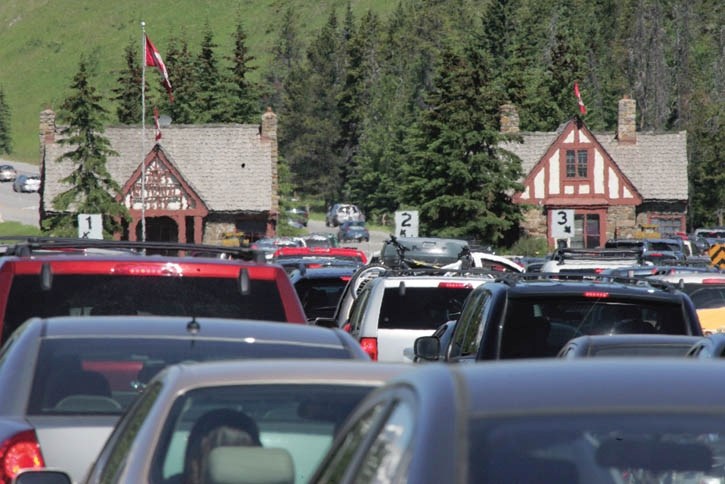BANFF – In many of the Indigenous languages represented in Treaty 7, there is no direct translation for the English word ‘welcome.’
In Stoney, the word ‘okâch,’ meaning come in, there is room, is often used. In Cree – which is also spoken by many Métis people – ‘tawâw’ translates to a similar meaning, greeting newcomers with the offer of open space.
These words and others in the Tsuut’ina and Blackfoot languages – the latter of which is traditionally spoken by the Blackfoot Confederacy Nations of the Kainai-Blood Tribe, Siksika, and Piikani – may soon welcome visitors into Banff National Park, an area Indigenous peoples were once excluded after having called it home for thousands of years.
“We want to make sure that it’s done officially in our languages,” said Violet Meguinis, Tsuut’ina Nation consultation director and a member of the national park’s Indigenous advisory circle. “The whole idea of inclusion and reflecting on and respecting Indigenous peoples history starts here.”
Meguinis, and several others representing Treaty 7 First Nations on the park’s advisory circle, have been discussing the idea of creating an Indigenous welcome sign at the east gate of Banff National Park for the past several months.
Parks Canada’s Banff field unit is supportive of the idea and there are hopes a sign may be in place as soon as this spring. In its current stage, Indigenous members of the roundtable are working with elders and knowledge keepers in their respective communities to determine how to best translate each greeting.
“I went to our Tsuut’ina Language Institute and asked them to give me a translation of how ‘welcome’ would sound in our language,” said Meguinis. “They’ve sent me something, but we are still working on it. By our next meeting though, we’re hoping everyone will have something put together.”
Tsuut’ina, also known as Sarcee, is part of the Dene language family and is spoken only in Alberta with 90 people reporting it as their mother tongue in the 2016 census. Given how few people speak the language and their efforts to preserve it, Meguinis said it is all the more important to see it used in public.
Elder Tina Fox of Îyârhe (Stoney) Nakoda First Nation, while not part of the advisory circle, said seeing a welcome sign in the Stoney language at the east gate, or anywhere in Banff National Park, would be a marker of progress on the part of Parks' relationship with Indigenous peoples.
“Welcoming visitors in the Stoney language is very important for the Îethka people here at Morley,” said Fox. “That was our traditional land in the first place.”
The national park is home to many culturally significant sites to that of the Îyârhe Nakoda, as well as other area Indigenous peoples. Long before the Bow Valley was settled, the Îyârhe Nakoda had named many of the lakes and mountains that have come to be much better known by their settler-given names.
These include Minn-waki (Lake Minnewanka), Horâ Juthin Îmne (Lake Louise) and Eyarhey Tatanga Woweyahgey Wakân (Tunnel Mountain). These names translate to Lake of the Spirits, Lake of the Little Fishes and Sacred Buffalo Guardian Mountain in Stoney.
The Îyârhe Nakoda called Lake Minnewanka Lake of the Spirits because they believe the water has a spirit, said Fox. People would, and still do, visit the lake for ceremonial reasons.
The same could be said for Mînî Rhuwin (Sulphur Mountain), home to the Banff Upper Hot Springs.
“We went there for healing ceremonies. People that were sick were taken up there and we considered the hot springs to be a healing source,” said Fox.
But that important history, she said, is not yet widely recognized. Mainly because Indigenous representation has been lacking throughout discussions around history, tourism and conservation in the park until recent years.
In her time on the advisory circle, which formed in 2018, Meguinis said she has been encouraged by the discussions taking place with Parks Canada.
“We’re starting to see more tangible efforts take shape working with the national park,” she said. “It’s all well and good to have an advisory group, but I have mentioned this in conversations before that we’ve got to make those recommendations more concrete, more real.
“[The sign] is something that’s actually happening, and while it may seem small, it’s going to be a real benefit.”
Mike Oka, consultation coordinator for the Kainai-Blood Tribe and member of the roundtable, said he agrees the sign is a small gesture that represents a big step in the right direction toward Truth and Reconciliation.
“It would really benefit Indigenous peoples to be acknowledged in this way – to see a sign up there in their native tongue brings a sense of belonging to that area that hasn’t been represented as strongly in recent memory,” he said.
The Outlook reached out to Parks for comment but a spokesperson could not be made available before publication.
The Local Journalism Initiative is funded by the Government of Canada. The position covers Îyârhe (Stoney) Nakoda First Nation and Kananaskis Country.




